by Heather | May 13, 2024 | diy beginner tips, how to diy
Tips for Managing DIY Projects at Home
I've been DIY'ing Home Projects for several years and have a good rhythm down now. Depending on the phase of my life, sometimes I'm moving through them fast and other seasons I'm moving at a turtle's pace.
Now matter what phase you are in, there are fundamental aspects for completing DIY home projects successfully without causing more chaos in the house. If your house is like mine, it's already a little chaotic… in a, “We live hard in our home!” kind of way. So, just knowing a few of these tips to help you manage your DIY projects will save some sanity I promise.
Right now, my era is moving slowly through DIY projects. Which means we have to live in and around the “construction zone” much longer than usual.
Here are a few tips that help me manage DIY projects at home:
Communication
Inform everyone in the household what DIY projects you plan on working on. This will help avoid disruptions and misunderstandings as you get started. My husband has a little bit of cleaning and organization OCD. I've learned he is much calmer when he knows what projects are being worked on.
Protip: Get in the habit of spending at least 15 minutes writing and planning each DIY project. Here is a free planner I like to use.
Setting Goals and Due Dates
Completion dates help your household have an idea on when projects can be done. Just make sure you aren't over ambitious. Especially if you are a beginner, I say double your estimated time, trust me it always takes longer. 😉
Setting goals not only helps your family with their expectations, but it's a great habit to get into for yourself. It provides you with better direction and purpose during your DIY home projects. It helps you focus your efforts, work quickly and prioritize tasks.
You want to try to avoid disruptions and misunderstandings along the way, and these goals are a great process and visual for everyone – just post them up on the fridge.
Organization
Staying organized during home projects is e ssential. You task planner helps with keeping your to do list organized, but now you need to physically stay organized. I have a cheap basket I grabbed from TJMaxx and I just keep all my tools in it and tucked in a corner close to where I am working.
Take 10 minutes after each time you work on your DIY project to clean up and put your tools away. I can't tell you how much this has helped me with my projects as a person with slight ADD and has to focus on staying organized.
It's also important from a safety standpoint. Make sure all batteries are out of power tools, everything is unplugged and sharp pieces are in your basket. If you have smaller kids who would get into a basket, keep it tucked in a closet or high off the ground.
Balance
When I first started my DIY journey, I definitely let it consume more time than it should have. I mean, I was excited and wanted to see the end result.
Now it's important to be the best version of myself which means finding balance, especially as someone who gets wrapped up and passionate about my projects. I like to set “working hours” and I also like to make sure I have a plan for my kids during my working hours.
Once I am done with my tasks, I can go back to life, mumming and wifing!
Delegate Tasks
My kids might groan a little, but at the end of the day getting them involved is beneficial for everyone. It helps them learn something new,
Delegating DIY tasks to kids and family members fosters bonding by creating a shared experience and opportunities to get off electronics to hang out together.
My kids have been helping me for years, it's tasks that involve teamwork, problem-solving skills and instills a sense of responsibility for them. My son is 14 as I write this and things he does on his own just amaze me. He puts together furniture for us, he changed his own door knob, he hangs up wall decor and can fix things on his own.
Give them some options for rewards once they finish, like a game night or go out for fro-yo!
Budget Management
This is definitely an important part of the planning phase especially if you are tight on fund. Plan and track expenses carefully to avoid overspending and stay within budget for home improvement projects.
Ask for Help if Needed
Don't hesitate to ask for assistance from friends and family if needed. One time we invited some friends over for a BBQ and put together one of those jungle gyms in our backyards. It was a pain in the butt, but we had a good time doing it all together. DIY is more fun with friends who want to help.
Even if you need to seek experienced individuals if encountering challenges beyond your expertise, just know it's ok and happens every once in a while. Ask around in your neighborhood or send me a DM and I'll help anytime I can.
I also have a free community for DIY beginners that I help – constantly cheering them on with their projects and we have live DIY challenges we do together to learn and expand on your skills.
Celebrate Achievements
Especially as a DIY beginner, this is important. We all need small wins and pats on the backs. So, acknowledge and celebrate those goals you reach during DIY projects to boost morale and foster a sense of accomplishment.
It always gives you gets you motivated and excited to reach that next goal.
That's a Wrap!
For some additional ideas on how to start your DIY journey, here are my top 20 ways to learn DIY beginner skills
Keep in mind everyone will have their top priorities depending on what's important for your family during different times in life. Right now my top priorities are balance, communication and organization.
I hope you found these helpful. Leave a comment if there is something unique you do to find success at home with managing your DIY projects.
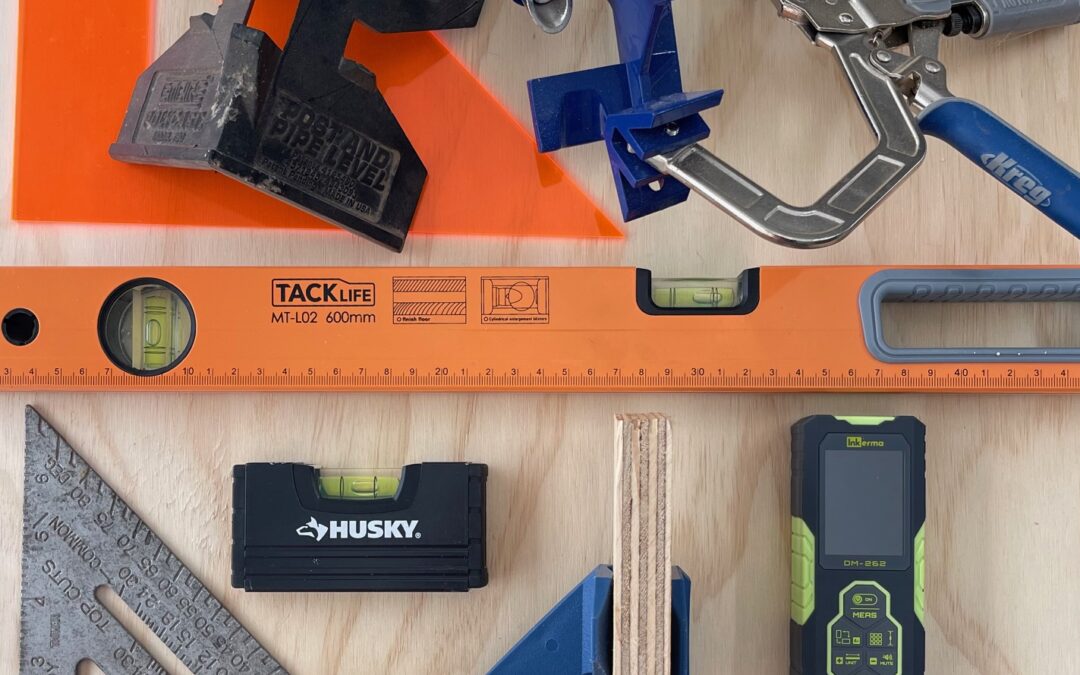
by Heather | Mar 26, 2024 | diy beginner tips, diy projects, woodworking tips
Two hand tools as a Woodworking beginning & for DIY home projects you will need is a speed square and a bubble level.
You know the saying “don't be a square” – aka not cool or just not nice? It's quite the opposite when it comes to Wood Working and DIY. You actually want to be square – well you want your DIY & Woodworking projects to square.
Projects being square is one of the most important lesson (besides safety) that I've learned when it comes to building furniture, woodworking and DIY home projects.
Always ensure your projects are level, plumb & square from the very beginning. In this blog post I'll talk about those terms mean, the different types of squares and levels and what they are used for.
I'll also go over step by step instructions on how to use them. And provide tips for getting your wood working and DIY projects aligned from the beginning to eliminate mistakes. Let's start with what being square means.
The Terms & Definitions for Woodworking & DIY Beginners:
- Level: When an object or surface is level, it means it is perfectly horizontal or parallel to the earth's surface, like a ball sitting on top won't roll, ha! In woodworking, ensuring surfaces like shelves, tabletops, or countertops are level is essential for functionality and aesthetics. A level surface ensures that objects placed on it will not tilt or roll and provides a visually pleasing result.
- Plumb: Plumb refers to an object or surface that is perfectly vertical or perpendicular to the earth's surface. In woodworking, ensuring that structures like walls, posts, or cabinets are plumb is crucial for stability and structural integrity. This ensures that the weight is distributed evenly and prevents leaning or tilting, especially in load-bearing elements.
- Square: Squareness in woodworking refers to the angle formed between two intersecting surfaces, typically 90 degrees. Ensuring that corners, joints, and edges are square is essential for proper fitting, alignment, and stability of the overall structure. This ensures that pieces fit together accurately and results in a professional-looking finish.
In summary and an easy way to remember: horizontal (level) or vertical (plumb) level, plumb, and square are fundamental concepts in woodworking and DIY projects that basically means the surfaces are flat, vertical, and properly aligned.
First, let's dive into why this step is SO crucial for success.
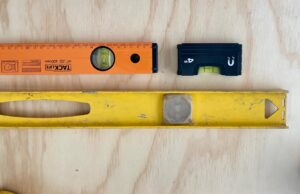
(As an Amazon Associate I earn from qualifying purchases at not additional cost on your end)
Reasons Why Getting DIY Projects Square is Key:
- Stability: Square and plumb structures are more stable, ensuring longevity and safety.
- Functionality: Properly squared furniture pieces fit together seamlessly, enhancing usability.
- Ease of Assembly: Square components make assembly straightforward and reduce frustration and ensures pieces are more compatible and easier to integrate with other furniture or structures.
- Precise Measurements: Ensuring squareness helps maintain accurate measurements throughout the project and can help you catch mistakes during wood working & DIY projects
- Alignment: Square components align correctly, preventing misalignment issues down the line.
- Mitigating Warping: Square projects also helps minimize the risk of warping or twisting over time.
- Aesthetics & Professional Finish: Squareness lays the foundation for flawless finishes, adding to the overall appeal. Square edges and corners result in a polished, professional appearance for your projects.
Achieving squareness from the very beginning is key to a successful project completion.

Furniture Building Tips Using a Level & Square
When it comes to furniture building, making sure your pieces of wood are square and level is crucial for a sturdy and visually appealing final product.
One tip is to always double-check your measurements and use a reliable square tool to ensure precise angles. Additionally, when attaching legs to a table or any other structure, make sure they are perfectly square unless the design calls for a specific angle. You don't want your table to wobble! Trust me, I've had to fix this once and it wasn't fun having to redo the work I just completed.
Utilizing clamps during assembly can also help keep pieces aligned while glue dries and maintain squareness throughout the build. They make different types of corner clamps and framing square jigs that you can buy to help assist while getting your corners squared up.
If something isn't perfectly square, make adjustments before the glue sets. Often, simply readjusting the position of a board, loosening a screw or clamping the boards can square them up.
Investing in quality leveling tools, such as a bubble level or a laser level, can greatly assist in ensuring all components are perfectly level, resulting in a professional finish. By following these tips and utilizing the right tools, you can create furniture pieces that are not only visually appealing but also built to last.
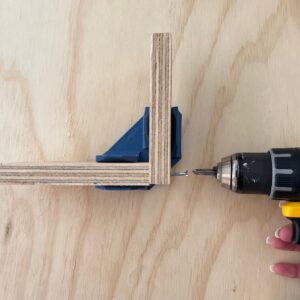 Accent Wall Tips Using a Level & Square
Accent Wall Tips Using a Level & Square
Creating a stunning accent wall begins with ensuring it's square and level from the get-go. Of course there are plenty of designs like the herringbone wall and geometric designs where your guidelines might look a little different.
But for accent walls like board and batten and shiplap, start by marking level lines on the wall using a carpenter's level or laser level. These lines serve as a guide for the placement of your wood trim or shiplap. When installing the trim or shiplap, it's essential to use a stud finder to locate and mark the studs in the wall.
Heavier woods should be anchored into studs, but there is a “criss cross” method or hack using the brad nail gun for drywall attachment only.
This ensures your pieces have a solid anchor for support. Additionally, using the ceiling and floor as reference points can help maintain straightness and centering. However, always double-check with your level to ensure accuracy. When installing each piece, use finishing nails or a brad nailer to secure them in place, ensuring they're flush with the level lines for a seamless finish. By following these tips and utilizing the proper tools, you can achieve a perfectly square and level accent wall that adds depth and character to your space
Before making your cuts, it's recommended to trim approximately 1/4-1/2” off your board. Typically, the ends of boards purchased from stores aren't perfectly square. Trimming off a bit ensures they're squared up for accurate cuts.
Here are a few different types of squares:
- Speed Square: A versatile tool used for marking angles and making square cuts, particularly in carpentry and roofing. It features a triangular shape with various markings for different angle measurements. The speed square what I use the most in my woodworking and DIY projects. It's affordable and efficient.
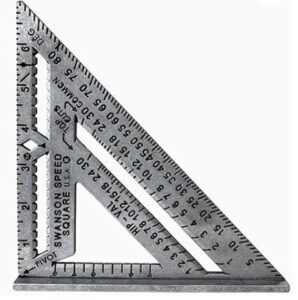
(this is the one I bought) amazon affiliate link
- Framing Square: Also known as a carpenter's square, it's primarily used in framing carpentry for laying out and cutting rafters, stairs, and framing joints. It consists of two arms, one long and one short, typically at a 90-degree angle. I have one my dad gave me and I've used it a few times during bigger DIY home projects
- Miter Square: Specifically designed for marking and cutting precise miter joints at various angles, commonly used in woodworking for trim and molding work.
- Combination Square: This tool combines a ruler and square head, allowing for precise measurements and marking of 90-degree and 45-degree angles. It's commonly used in woodworking and metalworking.
- Try Square: A simple square with a stock and blade at a 90-degree angle, used for checking and marking right angles in woodworking and carpentry.
- Adjustable Square: Similar to a try square but with an adjustable blade, allowing for flexibility in marking and checking angles other than 90 degrees.
- Engineer's Square: A precision square with a hardened steel blade and stock, used for checking the accuracy of machinery and metalworking projects
- Rafter Square: Similar to a framing square but with additional markings and measurements specifically for laying out rafters and roof pitches, commonly used in carpentry and roofing.
Tips for How to Use a Square:
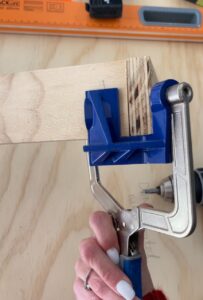 Align one corner of the speed square with a corner of your project and verify if both sides align with the square throughout. Just as you always double-check your measurements, check your corners through out your project especially as your in progress. Depending on what project you are working on, the angles and squareness can get shifted as you build.
Align one corner of the speed square with a corner of your project and verify if both sides align with the square throughout. Just as you always double-check your measurements, check your corners through out your project especially as your in progress. Depending on what project you are working on, the angles and squareness can get shifted as you build.
Another way to double check, is to use a tape measure to measure from one opposite corner to another, repeating the process for all corners. Consistent measurements indicate a square project.
Each type of hand tool square serves specific purposes in various trades and projects, ensuring accuracy and efficiency in layout and construction tasks. I suggest starting with the most common speed square for beginner wood working and DIY projects.
Here are a few different types of levels:
- Bubble Level: Also known as a spirit level, it's a basic level with a bubble vial filled with liquid and an air bubble. It's used for determining if a surface is horizontally or vertically level by centering the bubble between two reference lines.
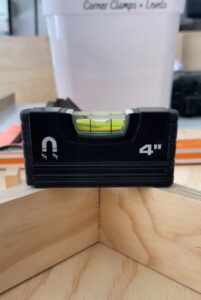
- Torpedo Level: A smaller, compact level with a torpedo-shaped body, often with magnetic edges for attaching to metal surfaces. It's useful for tight spaces, such as plumbing work, and for checking horizontal and vertical alignment.
- Box Level: Featuring a rectangular body with multiple vials for checking horizontal, vertical, and sometimes diagonal levels simultaneously. It's commonly used in carpentry, construction, and general household tasks for ensuring accuracy in larger projects.
- Digital Level: Utilizes electronic sensors to provide precise digital readings of angles and levels. It often includes features such as a backlight display and audible signals for accuracy. It's beneficial for highly accurate measurements in professional settings like engineering and surveying.
- Line Level: A small, lightweight level with hooks or notches for attaching to a string or line. It's primarily used in construction and landscaping for ensuring straight and level lines over long distances, such as when installing fences or decks.
- Laser Level: Projects a visible laser beam onto surfaces to provide precise horizontal, vertical, or angular reference lines. It's ideal for large-scale construction projects, such as setting foundations or installing tiles, where accuracy over long distances is critical.
Each type of level serves specific purposes in different trades and projects, ensuring precise alignment and accuracy in various applications.
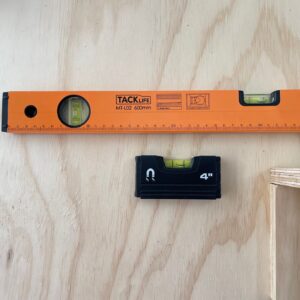 Tips for How to Use a Level
Tips for How to Use a Level
I can't think of a project I haven't used a level and some type of square on, minus crafting and DIY home decor. Here's a quick instruction guide for using a bubble level.
Begin by placing the level on the surface you want to check. Adjust the position until the bubble in the tube is centered between the lines.
For horizontal leveling, move the level along the surface until the bubble is centered. Try your best to get the bubble in the very center, and just use your best judgement and don't be overwhelmed with perfection. The two lines are there as a guide, so your best guess between those will do.
To check vertical surfaces, align the level vertically and adjust until the bubble is centered. Again use your best judgement to get it as centered as possible.
When using a bubble level, make sure it's in good condition and free from dirt or damage that could affect its accuracy. I have one that my dad gave me that started not to work.
Additionally, always check the level against multiple points to ensure consistency and accuracy throughout your project

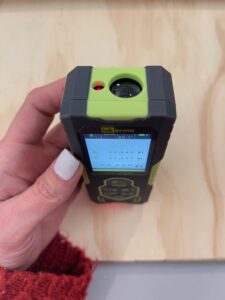
How to Use a Laser Level
Generic steps on how to use a laser level to ensure accurate and precise measurements:
- Setup: Start by placing the Inkerma laser level (the one I own) or any level of choice on a stable surface or mounting it securely to a tripod. Ensure that the level is positioned at the desired height and location for your project.
- Power On: Turn on the laser level by pressing the power button or switch. Some models may require you to hold the button for a few seconds to activate.
- Select Unit and Mode: Depending on your project requirements, select the appropriate unit measurement (I use inches) and the mode on the laser level. Common modes include horizontal, vertical, cross-line, or rotary modes. Adjust the settings according to your specific needs.
- Adjustment: Use the built-in adjustment knobs or buttons to fine-tune the laser level's position and alignment. Ensure that the laser lines are perfectly level or plumb according to your project's requirements.
- Placement: Position the laser level at the starting point of your project. Ensure that it is stable and securely placed to prevent any movement during operation.
- Alignment: Once the laser level is positioned correctly, activate the laser beam(s). Check the alignment of the laser lines against your reference points, such as walls, floors, or other surfaces. Make any necessary adjustments to ensure accurate alignment.
- Marking: Use a pencil or marker to mark the projected laser lines on the surfaces you are working on. These marks will serve as guides for your construction or installation tasks.
- Operation: Proceed with your construction or installation tasks, following the marked laser lines as guides for precise alignment and positioning.
- Monitoring: Throughout your project, periodically check the alignment of the laser lines to ensure that they remain accurate and consistent. Make any adjustments as needed to maintain alignment and precision.
- Power Off: Once you have completed your project or no longer require the laser level, turn it off to conserve battery power. Store the laser level in a safe and dry place for future use.
Some common modes and options found in laser levels include:
- Horizontal Mode: Projects a horizontal laser line across a surface, typically used for aligning objects or installing fixtures such as shelves or cabinets.
- Vertical Mode: Projects a vertical laser line, useful for tasks like aligning tiles, installing wall-mounted objects, or ensuring upright positioning of structures.
- Cross-Line Mode: Simultaneously projects horizontal and vertical lines, creating a crosshair pattern. This mode is beneficial for tasks requiring both horizontal and vertical alignment, such as installing drop ceilings or partition walls.
- Manual Mode: Allows manual adjustment of the laser beam's direction and angle, useful for custom alignments or non-standard applications.
- Rotary Mode: Projects a rotating laser beam in a 360-degree horizontal or vertical plane. Rotary laser levels are ideal for large-scale projects such as outdoor grading, landscaping, or laying foundations.
- Pulse Mode: Enables the laser level to emit pulses of light instead of continuous lines, enhancing visibility in bright light conditions or over longer distances. Pulse mode is often used with a receiver for outdoor applications or when working in challenging environments.
- Self-Leveling Mode: Automatically levels the laser beam within a specified range, compensating for minor surface irregularities or vibrations. This mode ensures accuracy and consistency in leveling and alignment tasks.
- Manual Leveling: Some laser levels offer manual leveling capabilities, allowing users to adjust the level manually using built-in controls or adjustment knobs. Manual leveling may be preferred for specific applications or when working on surfaces that are difficult to level automatically.
- Dual Slope Mode: Found in advanced rotary laser levels, dual slope mode enables the laser beam to project at two different slopes simultaneously, useful for tasks like grading or laying drainage systems.
- Remote Control: Some laser levels come with remote control capabilities, allowing users to operate the level and adjust settings remotely, enhancing convenience and efficiency, especially when working alone or in hard-to-reach areas.
These modes and options provide users with flexibility and versatility in laser level operation, catering to a wide range of construction, woodworking, and DIY projects.
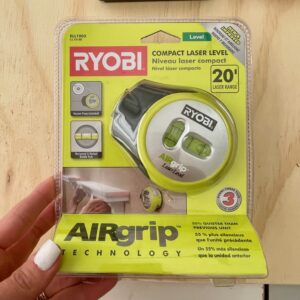
I hope you learned a bit more about how important it is to get your woodworking and DIY projects level and square from the very beginning. It's a crucial aspects of ensuring accuracy and precision in constructing projects and furniture assembly.
If you have any additional questions or tips I should add leave a comment or find me over on Instagram.
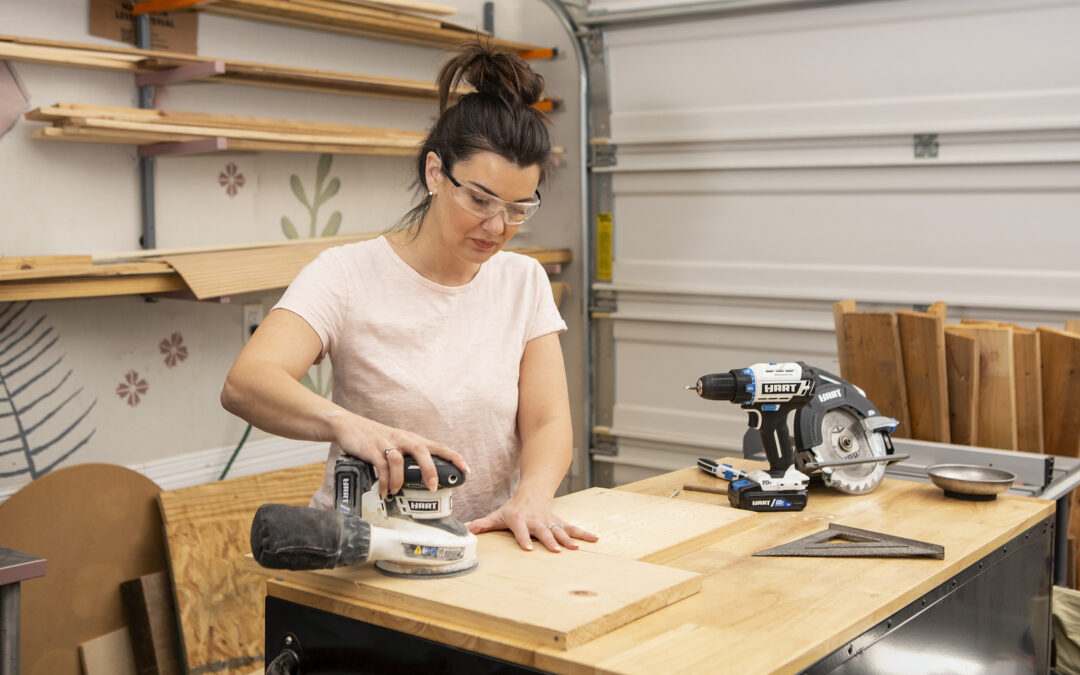
by Heather | Sep 26, 2023 | diy beginner tips, diy for beginners, diy projects, woodworking tips
Here are the top 20 ways & tips to learn DIY Skills
With the emergence of various online platforms, DIY has become more popular. Who doesn't love to watch a good DIY before and after?
People are now empowered to be more creative and resourceful in pursuing their DIY skills. Learning new or improved DIY skills is not only fun, but also practical. You can save money, create something unique, and have a sense of satisfaction seeing your labor of love. You will remember the day you look at your first DIY project and say, “I made that!”
If you're interested in learning how to DIY skills, below are 20 tips to help you head in the right direction.
Learn About Beginner DIY Tools
Learn what power tools are best for beginners. Each power tool is very learnable, but if you err on the side of caution and have anxiety, using tools that are rated as beginner tools will help you ease into it a bit more safer.
Before starting any project, you want to have the right tools. There are many different approaches to DIY home projects and some tools can be used for tasks they weren't intended for. This goes against safety standards though and it's not recommended especially for a beginner. Try to stick to using each tool for how it was made to be used.
It's important to do some research on the tools you will need as a beginner, and to complete specific projects. Here are a few tools I've rated as beginner friendly – a miter saw or possibly a jigsaw for smaller DIY projects, a power drill, an orbital sander and brad nail gun. Also, it's important to know that with almost every DIY project, you are going to use a speed square and level.
There are other essential tools that you should have in your toolbox, and I talk more about that in my free diy for beginner's basics kick-starter guide.

Watch Videos
There are numerous DIY videos available on different platforms. (YouTube, Instagram, Tiktok, Facebook) Find a few favorite DIY content creators you trust and would love to learn DIY skills from. Watching these videos will give you ideas and tips for starting DIY projects.
Unfortunately, some DIY steps can get left out of videos. So, you might have to watch a few different DIY project videos to get clear and detailed instructions on how to complete a task from start to finish.
Tackle the Basics
Starting with the DIY beginner basics allows you to gradually enhance your skills and confidence in DIY projects. Simple DIY projects such as painting your room, hanging curtains, building simple planters, adding shelves to a closet, convert a closet into a mudroom, simple accent walls in a kid's room are good examples of basic projects that you could learn DIY skills from.
I always suggest starting in a spare room, closet, kids room in case it isn't perfect the first time.
Finish Your Projects
It's soooo important that you complete your DIY projects. Make sure that you have enough time, focus, and resources to complete a project. Talk to your family about the timeline and helping with kids if needed. Schedule time in your calendar, and make sure you are well prepared. The sense of satisfaction you get from completing a project will give you the confidence to move forward with others.
Not to mention, you don't want to end up on the 95% club, because it starts to wreak havoc in your house and will eventually stress you out. Don't ask me how I know!!?!
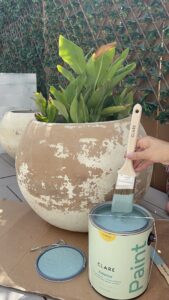
Start Small DIY Projects
I talked about some projects in the basics section, but I really wanted to emphasis SMALL. Starting on a smaller scale project than what you might normally do is great for DIY beginners. When you learn a new skill or hobby, it's essential to feel successful and encouraged. Some even small projects could be home decor upcycles, furniture flips, building a picture frame, or paint a color block accent wall.
Plan Plan Plan – Skills & Projects
Planning is crucial when it comes to learning DIY skills and doing projects. Before starting, take time to plan the project from start to finish. Identify the materials and tools you need; estimate the time the project will take and factor in any possible challenges. Sometimes this comes with experience, and you will get better with each project.
I will admit, I often start projects without a out plan. That works for me on occasion, so do what is best for you. If you are waiting because you don't have the perfectly thought out plan – then don't let that hold you back and just START somewhere.
Know What DIY PPE You Need
 Safety is a top priority when learning DIY skills and doing any DIY project. Make sure to wear protective gear such as safety glasses, ear protection, masks and possibly gloves to protect yourself from harm. At first it seems trivial, but it's so important to prevent any injuries. Over time saw dust and loud noises will have an adverse effect on your body. Remember, prevention is better than cure.
Safety is a top priority when learning DIY skills and doing any DIY project. Make sure to wear protective gear such as safety glasses, ear protection, masks and possibly gloves to protect yourself from harm. At first it seems trivial, but it's so important to prevent any injuries. Over time saw dust and loud noises will have an adverse effect on your body. Remember, prevention is better than cure.
Learn How to Measure Properly
Measuring correctly is essential and top on my list teaching my DIY beginner students. Accurate measurements ensure that your work is precise and of high quality. It prevents you from wasting time and money having to start over. Invest in a good tape measure, square and angle gauge.
Learn How to Cut Accurately
Cutting accurately is also essential when working with wood, metal, or any material. Know what tools are best for what cuts and types of material (sometimes types of wood as well). Practice your cutting skills and techniques before starting your project.
 Prepping the Material
Prepping the Material
Prepping your wood correctly is essential in any DIY project. Make sure to clean your materials, sand them down using the correct grit sequence, and remove any splinters or rough edges if needed. This will ensure that your work is neat and professional-looking. It's also essential for staining and painting.
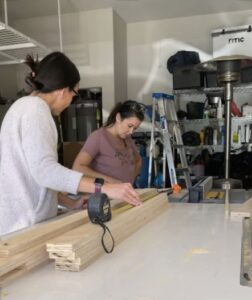 Take a Class or Course
Take a Class or Course
Taking a class or course is a great way to learn about DIY skills. There are numerous online and offline courses that you could take. Some community centers or home improvement stores even offer free classes and workshops on DIY projects. Find one that best fits your timeline and budget. Sometimes investing in yourself saves you time and money down the road. It equips you with the right knowledge and skills and can even boost your confidence and have a positive impact in helping you reach your goals quicker. Check out my DIY Kick Starter Course here.
Identify Your Interests
DIY projects are a broad category, and it's a good idea to identify what you like doing so you know the right DIY skills to learn. If you enjoy painting and decorating, focus on DIY projects related to interior design and home decor. You may not need as many tools going this route. It's also a great place to start to help you build up to more advanced DIY projects. If you want to build furniture or do cabinets or trim work, try focusing on DIY skills and projects that are more in line with woodworking and cabinetry.
Talk to Others You Know that DIY
Talking to people who are already doing ideas or who have already completed a DIY project can provide a wealth of knowledge. Ask for tips and techniques, learn from their mistakes. Learning a new skill is fun with friends anyway. You might even find a supportive community of DIYers who can encourage and inspire you.

Use High-Quality Materials
I agree this one is a little circumstantial to your situation and honestly the project. As a beginner, I don't recommend the investment until you have had a few projects under your belt. If the means are there, using high-quality materials on your DIY projects will make them more durable and long-lasting. Investing in quality materials may be more expensive, but sometimes it's worth the investment in the long run. Something to think about as you hone in on your skills and level up your DIY projects.
Practice Patience
Patience is essential in learning diy skills or any new skills. Some projects may take longer than expected, and it's important to be patient and focused throughout the process. Sometimes you have to work on projects in between life and kids. It can be frustrating because you are excited for the new project to be completed and see that pretty space done. Rushing through a project may lead to poor quality work, you skipping important steps or even injury.
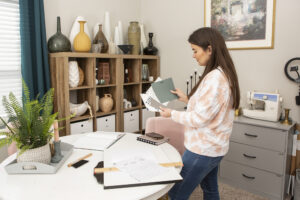
Get Creative (my favorite)
DIY projects are all about creativity and originality. I mean sometimes it's an exact dupe, ha! But, don't be afraid to experiment and come up with new ideas. I love trying to reuse things from around the house and making treasures from trash! Combine techniques and materials that may seem unconventional but work well together. Trust me, I have thrown out plenty of projects or home decor pieces that came out blotched from experimentation. Just have fun with it, and if you have friends or kids, get them involved.
Explore New Horizons
Challenge yourself by trying new DIY projects here and there, even if they are outside of your comfort zone. This will help you develop new skills, and who knows, you might find something else you really love to do!




 Accent Wall Tips Using a Level & Square
Accent Wall Tips Using a Level & Square
 Align one corner of the speed square with a corner of your project and verify if both sides align with the square throughout. Just as you always double-check your measurements, check your corners through out your project especially as your in progress. Depending on what project you are working on, the angles and squareness can get shifted as you build.
Align one corner of the speed square with a corner of your project and verify if both sides align with the square throughout. Just as you always double-check your measurements, check your corners through out your project especially as your in progress. Depending on what project you are working on, the angles and squareness can get shifted as you build.
 Tips for How to Use a Level
Tips for How to Use a Level





 Safety is a top priority when learning DIY skills and doing any DIY project. Make sure to wear protective gear such as safety glasses, ear protection, masks and possibly gloves to protect yourself from harm. At first it seems trivial, but it's so important to prevent any injuries. Over time saw dust and loud noises will have an adverse effect on your body. Remember, prevention is better than cure.
Safety is a top priority when learning DIY skills and doing any DIY project. Make sure to wear protective gear such as safety glasses, ear protection, masks and possibly gloves to protect yourself from harm. At first it seems trivial, but it's so important to prevent any injuries. Over time saw dust and loud noises will have an adverse effect on your body. Remember, prevention is better than cure. Take a Class or Course
Take a Class or Course
